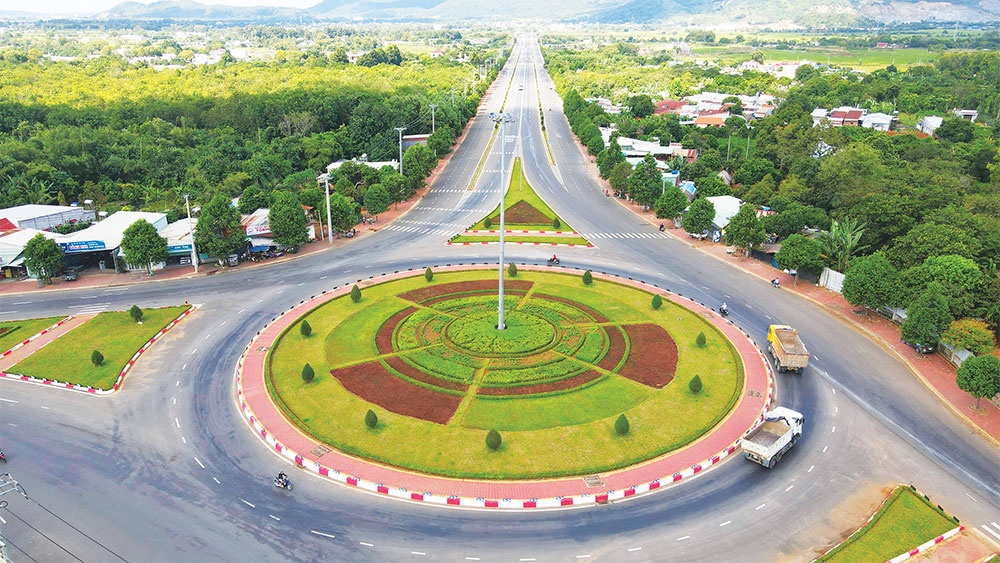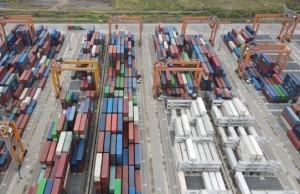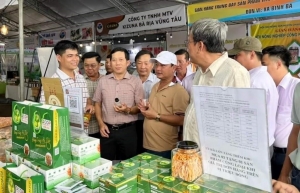Ba Ria-Vung Tau lacking inter-regional connectivity
“Ba Ria-Vung Tau has met all the conditions to develop a logistics centre and international transshipment seaport,” said Nguyen Van Tho, Chairman of Ba Ria-Vung Tau People’s Committee, at the Logistics Development Linkage Conference on September 8.
Tho said that logistics has been identified as one of the four economic pillars of Ba Ria-Vung Tau, thereby driving provincial socioeconomic development. As of the present, the province has developed a diverse logistics service system, with more than 300 businesses providing goods transportation and logistics warehousing services.
Ba Ria-Vung Tau has all the necessary conditions to develop a logistics hub, given that the local seaport system has taken shape.
The province is now home to 69 planned seaports and 50 projects in operation, with a total design capacity of 152 million tonnes per year. This is an important foundation for Ba Ria-Vung Tau to develop a logistics centre and international transshipment seaport.
“Once the important transportation routes connecting the southeast and southwest regions are formed, they will unlock the potential of the province. In particular, Long Thanh International Airport, which is only 30km away, is expected to bolster the strong growth in the future,” he said.
 |
| Ba Ria-Vung Tau lacking inter-regional connectivity |
Ba Ria-Vung Tau is one of the three important growth poles of the southeast key economic region. The province is in dire need of policy facilitation to form a free trade zone, which is a completely new model in Vietnam. Haiphong is developing following this trend, but only stopping at the economic zone.
“The formation of a free trade zone in association with seaports in the Cai Mep Ha area will create a driving force for the development of the southeast region,” said Pham Tan Cong, chairman of the Vietnam Chamber of Commerce and Industry.
The southeast region handles 45 per cent of Vietnam’s total cargo volume and more than 60 per cent of Vietnam’s container cargo throughput via the Cat Lai and Cai Mep-Thi Vai port systems. “Infrastructure is the biggest bottleneck, hindering the development of the southeast region,” Cong said.
Although Ba Ria-Vung Tau boasts a developed infrastructure, a seaport system, and diverse logistics services, the province has yet to meet the region’s requirements to develop maritime and multimodal transport.
There are 14,800 logistics service providers in the southeast region, accounting for nearly half of Vietnam’s total logistics businesses. Despite many advantages, the province needs solutions to ensure successful implementation of the southeast region connection plan.
However, the current institutional regime does not meet the requirements for development. As a result, the lack of regional connectivity has hindered Ba Ria-Vung Tau from further development, according to many domestic analysts.
Tran Thuong Chi, director of Ba Ria-Vung Tau Department of Transport said, “The lack of regional and inter-regional infrastructure networks has limited the development and spillover effect of the region. The province plans to expand the Bien Hoa-Vung Tau railway line to support the Cai Mep-Thi Vai international transit port system in the period after 2030.”
Only about 16 per cent of the expressways, which were planned to be completed before 2020, have been implemented. In addition, three planned belt roads must be completed before 2020. However, the construction of belt roads 2 and 3 has been 78 per cent and 18 per cent completed respectively. Meanwhile, the construction of Belt Road 4 has not yet been implemented, Chi explained.
According to many foreign investors, Vietnam is facing the opportunity to develop deepwater port clusters and logistics services. According to the master plan for seaport development during 2021-2030, the seaport system is expected to have a capacity of handling 38-47 million TEUs of container cargo, representing a growth rate of 7-10 per cent per year.
Pham Quoc Long, chairman of the Vietnam Ship Agents, Brokers and Maritime Services Providers Association said, “Cai Mep Port is poised to enjoy the best growth given that shipping lines have upgraded ship sizes to reduce shipping costs.”
The operation of ports depends on the demands to transport goods. Despite the shrinking demand amidst the economic downturn in many countries, Vietnam has huge potential for its seaport development thanks to a wide range of free trade agreements that Vietnam has signed, Long said.
He added that the seaport system can meet the needs of import-export growth. However, there are three bottlenecks hindering development.
First, the infrastructure has yet to stimulate import-export growth. The time for effective exploitation does not correspond to the long investment time. Another bottleneck is the progress of seaport projects.
“Container throughput at the Vietnamese seaport stands at 25 million TEUs per year. The figure is expected to increase to a higher level on the back of the recovery of trade and the global economy. Deepwater seaports are becoming more attractive to port operators and foreign shipping lines,” Long said.
At the 2023 annual general shareholders’ meeting, Do Cong Khanh, deputy general director of Gemadept said, “To unlock the potential of Cai Mep Industrial Park, the company has decided to implement Phase 2 of Gemalink Port to increase capacity to three million TEUs per year. Once the project is fully completed, the wharf line at this port cluster will be around 1.5km long and can accommodate ships of 250,000DWT, thereby creating a competitive advantage in the region.”
Gemalink Port is one of the seaports with the deepest draft in Vietnam today. Phase 2 of the port will be completed in 2025.
| Dr. Tran Thi Hong Minh, Director Central Institute for Economic Management
Infrastructure remains a hard nut to crack. Ba Ria-Vung Tau needs to determine the location and scale of the free trade zone in accordance with relevant plans, the current situation, and development of traffic connections and services (including logistics services) at regional and inter-regional scales. Leaders need to discuss and listen to the investor community, including foreign investors. It is also vital to review economic-trade policies and other policies related to human resource development and amenity development to serve business activities in free trade zones. Ba Ria-Vung Tau should invest in research and establish a streamlined and effective organisational model and management apparatus in association with modern and transparent thinking. The southern province should measure the results of the operation in the free trade zone. |
| According to the National Master Plan for 2021-2030, with a vision to 2050, the southeast region is oriented to become the largest driving force in the country. This is considered a guideline for the region to promote strong socioeconomic development, attracting both domestic and foreign funds. In 2022, the region’s total GDP accounted for 30.8 per cent of the country’s GDP. The registered foreign direct investment capital in the region makes up for 40.4 per cent of the country’s total, while the regional budget revenue accounts for 45 per cent of the country’s total figure. The southeast includes Ho Chi Minh City and the provinces of Dong Nai, Binh Duong, Ba Ria-Vung Tau, Binh Phuoc, and Tay Ninh. |
What the stars mean:
★ Poor ★ ★ Promising ★★★ Good ★★★★ Very good ★★★★★ Exceptional
Related Contents
Latest News
More News
- Unlocking capital flows for strategic and suitable projects (January 18, 2026 | 09:00)
- ACV begins cargo terminal construction at Danang Airport (January 17, 2026 | 15:57)
- Viettel starts construction of semiconductor chip production plant (January 16, 2026 | 21:30)
- Bel expands Vietnam production with $19.7 million investment (January 16, 2026 | 16:07)
- ASML signals long-term commitment to Vietnam (January 16, 2026 | 12:00)
- Ho Chi Minh City starts construction of four key infrastructure projects (January 15, 2026 | 17:22)
- PIDG invests with AquaOne to expand Xuan Mai’s treated water supply to Hanoi (January 15, 2026 | 11:16)
- Vietnam ranks 38th in global AI adoption (January 14, 2026 | 16:01)
- European business confidence reaches highest in seven years (January 13, 2026 | 10:17)
- Vietnam’s regional influence draws renewed global attention (January 12, 2026 | 13:59)





 Tag:
Tag:



















 Mobile Version
Mobile Version